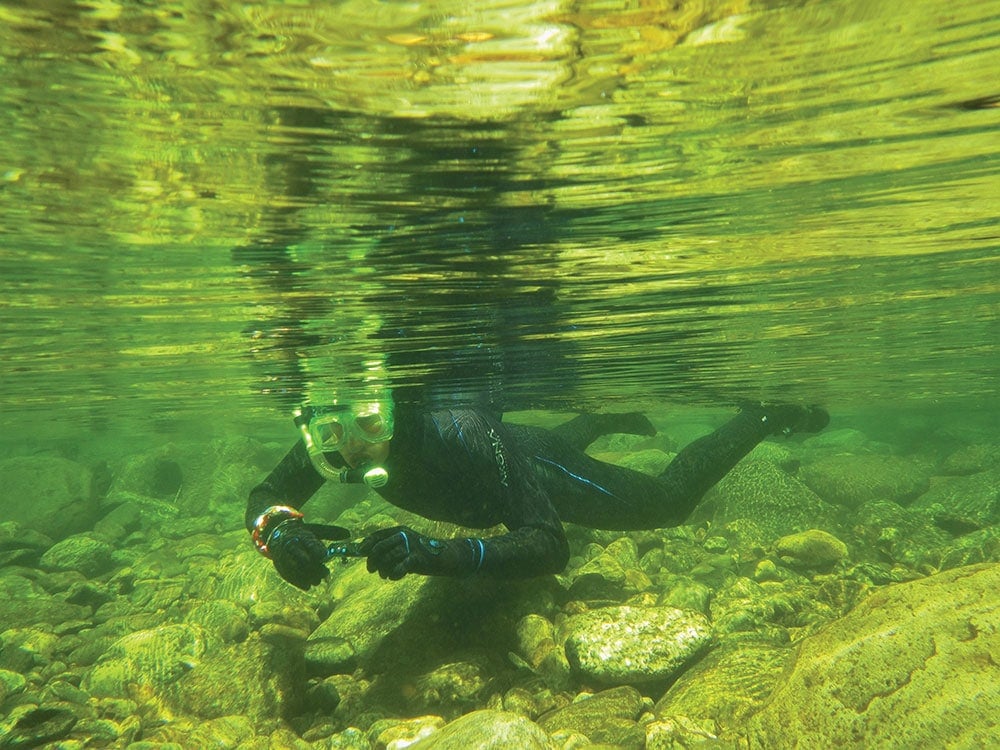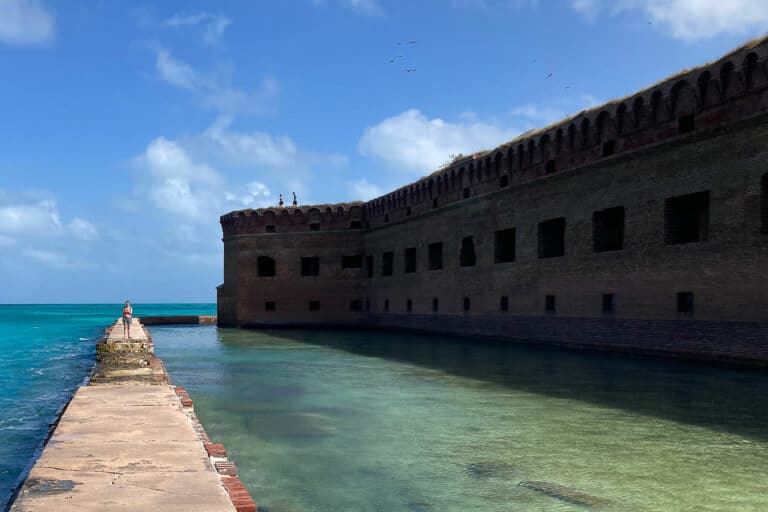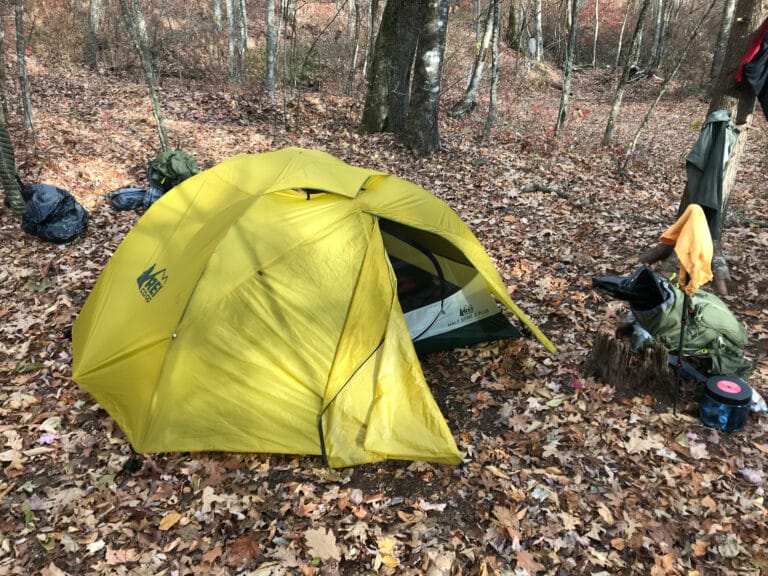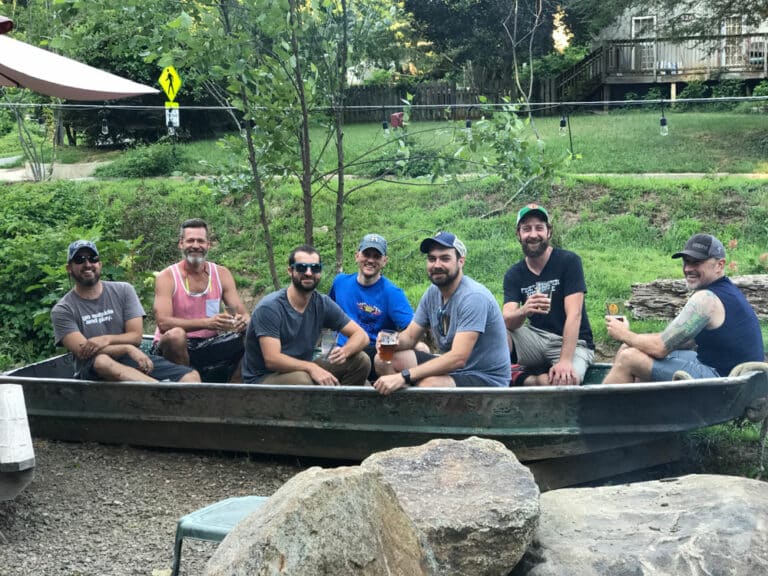River snorkeling is a great way for families to get outside, stay active, and explore nature.
When my two kids were small, family canoe trips were easy. Then they got older and things like who sits in front, where to stop and swim, accidental paddle-splashes, or simply passing a bag of chips, led to near-constant bickering. Next came gripes about sitting still. My spouse soon refused to participate.
What to do? Tubing trips brought their own problems. Kayaks required buying a tow vehicle and trailer. I started longing for the simple, infectious Zen of family snorkeling trips in Hawaii and the Caribbean. The activity bundled exercise, summer swimming, quiet, and immersive nature experiences like no other.
Then it hit me: Could we make it work in nearby rivers? I quickly added quality masks and snorkels to our tubing rigs and we hit the water. The response was an enthusiasm that—to my astonishment—dethroned skiing and snowboarding as my kids’ favorite outdoor to-do.
They delighted in exploring segments of rivers they’d complained relentlessly about having to paddle. Looking for fish and wildlife in underwater boulder fields, rocky crags, and gentle rapids brought endless amusement. They begged to stay despite fading sunlight and the need for dinner. At home, they consulted online freshwater guidebooks to discover what they’d seen.
Good news aside, there was a substantial learning curve. We wasted outings on botched antifog treatments. Our first long trip nearly got us stranded by nightfall. Outings centered around isolated, densely forested sections brought near-zero visibility. The list goes on.
But we learned quickly. And my kids have since become zealous advocates—urging friends and pretty much anyone we meet on the river to give the activity a try. I too wanna spread the message. Below is a guide to help you and your family get started.
FINDING SPOTS
The key to great family river snorkeling trips lies in finding good spots. That said, criteria for assessment will vary from group to group—depending on geography, kiddo swimming abilities, and so on. These tips and tricks will help attune your thinking and point you in the right direction.
What Makes a Good Location?
Freshwater snorkeling comes in three main forms: Exploring swimming holes and still-water areas, skulking upstream, and floating for longer distances downstream. So, deciding where to go depends on what you want to do.
But there are common ingredients. Above all, fun snorkeling experiences hinge on underwater eye-candy, so clear water, rocky bottoms, and interesting ecosystems are the ticket. Mountain rivers that feed major tributaries are typically a good place to start. Features like long, relatively slow-moving sections filled with big boulders are havens for fish. Riffles also offer interesting pockets of rocks and wildlife. In Virginia, for instance, the headwaters of the Maury River at Goshen Pass are exemplary.
Another important factor: Light. Dense, bank-hugging forests bring excess shade and occluded viewing opportunities.
Locate New Areas
Unfamiliar with regional waterways? Try checking the website of your state’s department of game and inland fisheries (or equivalent agency). Virginia, for instance, lists rivers by region and offers canoeing and kayaking info for many sections—including fishing hotspots, which are often great for snorkeling.
Another option is to call outfitters. They know the local rivers well and are typically happy to make suggestions. They also offer cheap shuttles for point-to-point trips. Some, like North Carolina’s Oxbow River Snorkeling & Backcountry Adventures, do guided experiences.
Planning
Calculating timing and mileages for downstream river snorkeling trips can be tricky. Some areas inspire lingering. Others, window-gazing as the current does its thing.
Initially, it’s best to start with shorter distances—say, a mile or less. Pick spots where, should you finish too quickly, it’s easy to shuttle up for a repeat. Because, if the spot is good, second runs are desirable.
GET EQUIPPED
Proper equipment is the foundation of great river snorkeling experiences. Luckily, quality gear is remarkably affordable. Here’s a list of essentials, with tips for choosing.
Masks
While bargain packages may work passably in swimming pools, they will leak and fail in rivers. Instead, invest in upper-midrange or high-end offerings from professional brands like Cressi or TUSA. A premium mask will slash learning curves and maximize good times.
But picking takes consideration. First and foremost is fit—a hair too big and you’ll get constant leakage. Visiting dive shops makes fittings easy. When buying online, take facial measurements and use sizing charts.
Next comes lenses. Tempered glass is a necessity. For younger kids, consider a dual-lens setup: Frames make them sturdier, less likely to fog, and easier to adjust. Adults and conscientious teens will enjoy frameless, single lens models—which offer a wider field of sight and better peripheral vision. The award-winning Cressi F1 sells for around $35.
Other considerations include skirts and buckles. The former should be high-grade silicone. For the latter, a frame-anchored quick-release system is best. Though slightly more expensive, they simplify adjustments considerably.
Snorkels
Buying a quality snorkel brings confidence that helps kids and adults adjust to the peculiarities of breathing while swimming underwater. Matching with mask brands ensures compatible connection systems and minimal obtrusiveness.
There are a few requisites for choosing. First is a reliable dry guard that bars water from entering the tube when you dive. Second is flexible construction—allowing for mobility that won’t compromise your mask’s seal. Next is a comfortable, properly sized, high-grade silicone mouthpiece. Lastly, a purge valve for blowing out saliva and water. The Cressi Alpha Ultra Dry is great and costs about $40.
Fins & Gloves
Gloves and fins are nice, but nonessential. (Ditto for wetsuits in summer conditions.) That said, they do enhance experiences. So, a word.
Fins increase mobility and swimming efficiency, helping you dive deeper, slice through currents, and better follow fish. They also protect your feet. Look for a pair with short fins, closed pockets, and rugged grippy soles. Head Volo Ones do the trick for about $30. Pair them with neoprene water socks to avoid blisters (under $20).
Neoprene diving gloves protect water-softened fingers and hands from sharp rocks and debris. They’re great for grabbing boulders, pushing off rocks while swimming downstream, and more. Webbed gloves are like fins for your hands. Both options run around $30.
Antifog Spray
Without it, lenses fog within seconds. Jaws brand Quick-Spit spray costs about $6 a bottle and should be applied on-site, each time you go out. Here’s how to do it right.
First, clean your lenses. Start by rinsing off debris and grit in the sink. Then use a toothbrush and toothpaste to gently scrub away facial oils, fingerprints, and grime. Pat dry and buff with a soft towel. Store masks in individual plastic containers or bags to keep them clean and prevent scratches.
Riverside, spray a few pumps of Quick-Spit onto your mask’s interior lenses. Tilt it from side to side, coating the glass totally. Then dip it into the water, washing away the solution completely. Repeat for the external lenses. TIP: If your face or fingers touch the glass, the point of contact will fog. So, bring along a cleaning kit just in case.
Innertube and Cooler Rig
Longer downstream swims bring considerations like portable hydration, snacks, and possible kiddie fatigue. Waterproof coolers and hydration packs can be lashed to sturdy innertubes with bottom-liners. The latter offer relief if someone needs a momentary break.
SAFETY & GETTING STARTED
Like mountain biking, skiing, and snowboarding, river snorkeling brings inherent dangers. Taking a few easy precautions minimizes risks.
Start Slow
Begin with a trial run in an area with clear water and easy conditions. A swimming hole with negligible current, rocky bottoms, and walkable shallow areas that give way to depths of about eight feet is ideal.
Small kids can wear life vests and catch interesting sights from the surface while learning to stay partially submerged and breathe through their snorkel. Older children can get familiarized with diving by belly-crawling in chest-deep water. That way, if they panic or get scared, they can simply stand up. Once they’re confident, they can move on to progressively deeper waters.
Use a similar approach for downstream trips. Begin with short journeys (.5 miles or so) in gentle currents with manageable depths and build from there.
Best Practices
• Protective footwear. Unfortunately, irresponsible fishermen, litterers, and floods create dangerous hazards in rivers. Stepping on a fishing hook, shard of broken glass, or jagged rocks can ruin a trip and spell a visit to the emergency room.
• Swim with buddies and stay close. Pay particular attention in areas with stronger currents and deeper waters.
• Be careful when rivers are high. Luckily, post-storm turbidity makes for bad snorkeling. Still, there are occasions when receding waters turn clear, but leave dangerously powerful currents. Check river gauges ahead of visits for depths and never swim in conditions that exceed any member of your party’s abilities.
• Floating Downstream. Navigating riffles and small rapids while snorkeling takes some getting used to. Start by assessing areas and picking lines ahead of time. Deeper spots are easy enough to swim. Tackle shallower areas by crawling along head first (in a superman position), picking your way from rock to rock. Drag your feet and grab boulders to control speed. Wearing gloves will boost confidence and protect your hands and fingers.
• Pollution. Sections of waterways near former or current industrial sites, power plants, cities, and so on, can sometimes be unsafe to swim in. When visiting new areas, first check for closures with your state’s department of game and inland fisheries (or equivalent agency).
Cover photo courtesy of Oxbow River Snorkeling & Backcountry Adventures, an outfitter offering guided trips in North Carolina.








